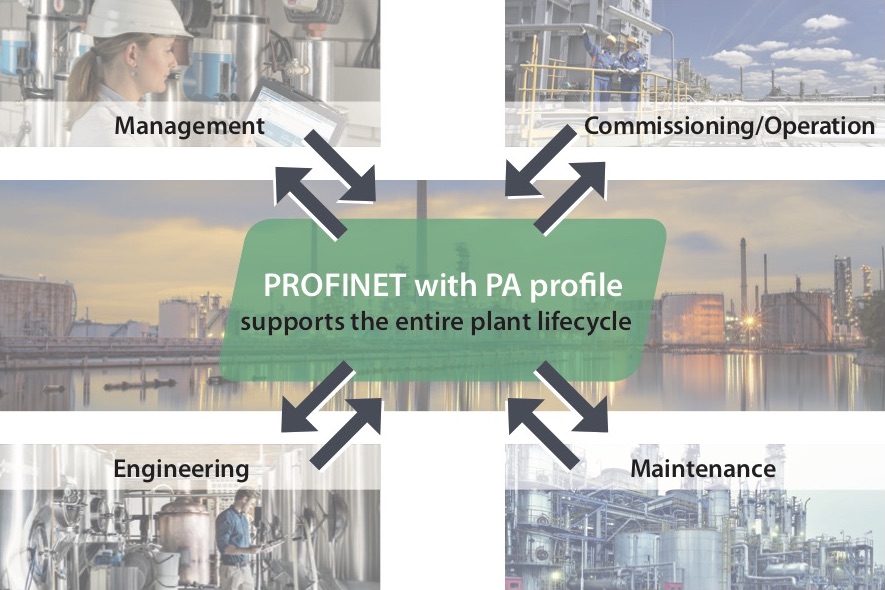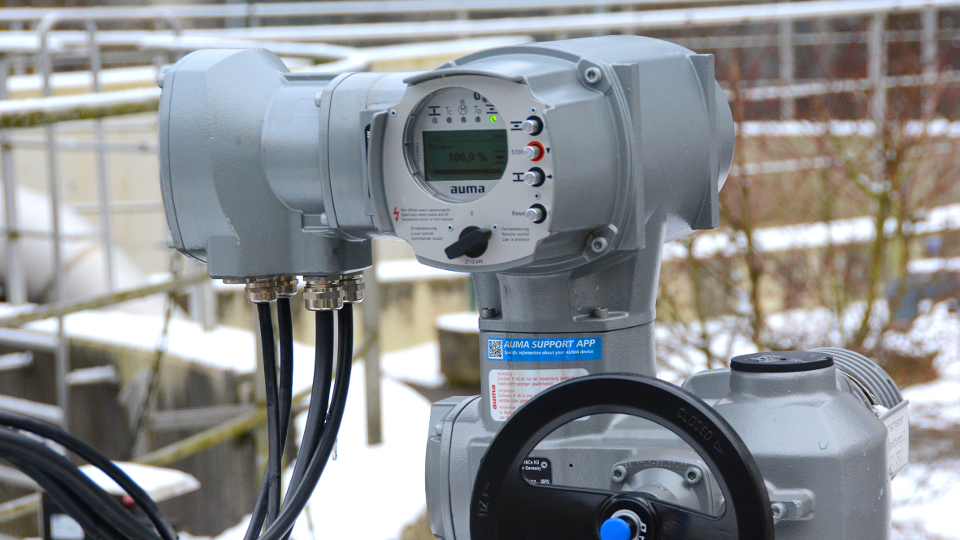Future-proof | Powerful | User-oriented
In the process industry, and in automation technology in particular, digitalization is currently a hot topic where the goal is to be able to respond to plant and market events quicker and more effectively than before. This concerns both process control and the capture of data and information from the plant. Both of these require powerful and continuous, plant-wide communication technology like that currently provided by Industrial Ethernet. Manufacturers are working together intensively with users on the use of this technology for process automation.
The project being conducted by PROFIBUS & PROFINET, which enables leading factory-automation (FA) PROFINET technology to also be used in process automation (PA), is one example. This includes the expansion of PROFINET functions to also meet the needs of PA, such as the recently published new PA Device Profile 4.0 focusing on PROFINET. Also part of this is the development of an advanced physical layer (APL) for the use of Industrial Ethernet networks – including in potentially explosive zones – and device integration with FDI as well.
This PI development offensive relies on intensive contact with users like the NAMUR and their experience and expectations. As a result, “PROFINET with PA Profile” now offers concrete benefits for all four phases of a plant’s life as shown in Figure 1 and explained below.

Management tasks: Equipment Preservation and Future-proofing
Equipment Preservation
The primary management task of process technology plants is the long-term management of investments made, while also ensuring the competitiveness of plants through continual modernization. Considering the fact that many plants are in operation for around 30 years and taking the high speed of innovation in some areas of technology into account, this is a major challenge! Having accepted this challenge, PI consistently protects existing plants with solutions for migrating older plant components to modern automation structures. This applies:
- to the integration of installed 4 – 20 mA or HART infrastructure into the fieldbus technology of PROFIBUS DP.
- to the bridging of PROFIBUS DP with process technology through the use of PROFIBUS PA technology via the MBP layer with intrinsically safe 2-wire line and device infeed.
- to the migration of PROFIBUS PA with PROFINET using proxy technology. Proxies are gateways found on the PROFINET network which represent the actual physical devices there, such as PROFIBUS PA devices. This enables the control system to access the devices and their functions to be utilized in the world of PROFINET.
Future-proofing
The future-proofing of process industry plants down to the field level with PROFINET is based on the use of the global Ethernet standard (IEEE 802.3), the use of the new PA Profile version 4.0 and the application-oriented PROFINET functions. This includes TCP/IP support for the parallel use of web technologies and for the integration of “common” Ethernet devices. In process technology, being future-proof also means being able to operate in potentially explosive zones with line lengths up to 1,000 m. PI is pursuing this goal through the joint development of the APL (advanced physical layer) as a robust, 2-wire, powered Ethernet layer for the direct connection of process devices to PROFINET, including in potentially explosive atmospheres.
This isn’t the only aspect of future-proofing offered by PROFINET, though. Large volumes of data are generated by intelligent field devices and processes at process industry plants – data which previously could only be used to a very limited extent. This data represents valuable potential which can, in the future, be evaluated using Ethernet systems like PROFINET (digital twin) and used to make decisions.
Plant engineering: Flexible and Reliable
The engineering of a plant primarily involves the specification of the plant topology, selection and addressing of the field devices and configuration of the PROFINET submodules. These tasks are simplified considerably in comparison to previous processes through the use of PROFINET functions and with the help of the new PA Profile version 4.0.
The Benefits of PROFINET Functionality
The wide variety of possible PROFINET topologies enable flexible network construction with regard to spatial expansion and redundancy of the transmission path. Line, star, ring and tree topologies are all supported. Devices are connected using switches as network components which are often already integrated into the field devices.
The Simple Network Management Protocol (SNMP), which can be used for error detection for example, is used to monitor the network components. Using the Link Layer Discovery Protocol (LLDP), information is exchanged for the purpose of PROFINET device “neighborhood detection,” where the respective neighboring device is clearly identified and the physical structure of the overall PROFINET network can be displayed. This makes it possible to compare the actual topology with the intended topology, enabling you to quickly and easily localize changes (and errors) in the topology. This function is also the basis for automatic name assignment for replacing devices with no risk of mix-ups.
The Benefits of Profile 4.0 Functionality
Process technology field devices from different manufacturers use the same measurement and control principles, but are equipped with different functions. The PA Device Profile, which establishes common core functions for all profile devices and thus ensures that different devices can work together, has long been used for operating such devices on a single bus. This PA Profile is available for use on PROFIBUS in its current tried-and-tested version, 3.02. It has now been developed further and made more resilient for use on PROFINET and modified to meet user requests as well. The NAMUR standard parameters (NE 131) are now used as device parameters, and the profile GSD files have been converted to the measurement principles (pressure, tank level and flow) and the actuators as a commonality between the field devices. This makes it easier to replace devices and also permits a “neutral,” i.e. manufacturer-independent, project planning process. So-called startup parameters, which are transferred immediately from the controller to the new device along with the unit of the measured value when the device is installed, have been introduced for the first time in Profile 4.0. This results in immediate preliminary operational readiness of the device. The tried-and-tested NAMUR diagnostic model was retained for device diagnostics and supplemented with the revised NE 107 edition from 2017.
Commissioning: Quick and Easy
PROFINET offers an array of functions which simplify and accelerate the commissioning of prior systems and make them more reliable. For example, each field device is automatically assigned its own name which uniquely identifies it within the system. This name is automatically assigned to a device during commissioning of the engineering tool of the controller using the DCP protocol (Discovery and Basic Configuration Protocol) as part of the “device baptism.” Double address assignment is reliably prevented by this. No manual access is required directly at the field device here, which eliminates the need to cover large distances, saves lots of time and also prevents setting errors from being made.
Potential wiring errors can be consistently localized using simple line testers and thus quickly remedied. Manageable distances of about 100 m between the devices also help here when using classic Cat. 5e cabling, as this “granulates” the plant and makes it much more manageable. Should it be necessary to perform actions at a specific device, the Indicate Device function – which causes the affected device to blink, eliminating the need for lengthy searching – can be of assistance. The Dynamic Reconfiguration (DR; formerly known as Configuration in Run (CiR)) function is also very helpful, as it permits elements of the plant to be accessed without restarting devices or controllers and without affecting network communication. This makes it much easier to make changes to the device configuration and add or replace field devices. If a device has to be replaced, the “neighborhood detection” function mentioned above – with its automatic name assignment feature – ensures quick and reliable device replacement.
Plant Operation: Dependable and Efficient
Every plant operator has a “wish list” for the operating behavior of their process industry plant: centralized (remote) information availability, timely detection and localization of malfunctions with as much detail as possible, all-around short response times in case a fault occurs, short distances for required access, meaningful diagnostics information for preventive maintenance and – especially important here – easy device integration in case of expansion or failure. “PROFINET with PA Profile 4.0” fulfills these wishes in the best possible way using functions which are already useful in both engineering and commissioning: continually updated ascertainment of the current topology, easy device replacement thanks to startup parameters and neighborhood detection, device naming without risk of mix-ups, automatic address assignment, short response times thanks to a high bandwidth, easy line diagnosis using the network structure, additional information from the field devices via separate Ethernet access etc. – the wish list is being vigorously tackled all the time. The digital transformation is also a key issue in the process industry:
Therefore, this article, PROFINET with PA Profile in Process Industry Plants, provides the technological basis for such digitalization in process automation.

Karl Büttner
Endress + Hauser
Head of the “PA Marketing” PI Working Group
Werner Längin
AUMA Riester
Member of the “PA Marketing” PI Working Group
